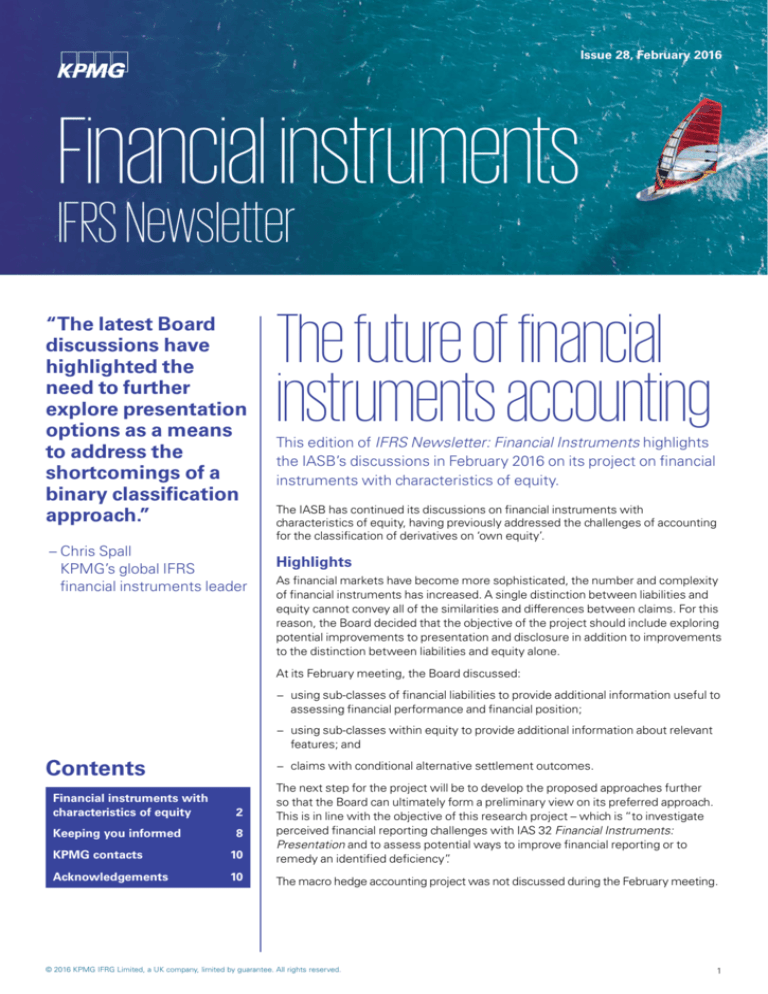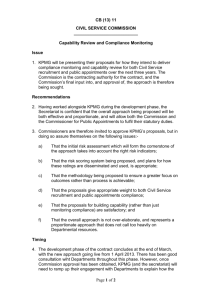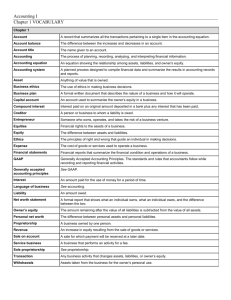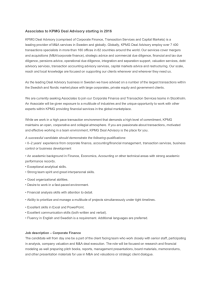
Issue 28, February 2016
Financial instruments
IFRS Newsletter
“The latest Board
discussions have
highlighted the
need to further
explore presentation
options as a means
to address the
shortcomings of a
binary classification
approach.”
– Chris Spall
KPMG’s global IFRS
financial instruments leader
The future of financial
instruments accounting
This edition of IFRS Newsletter: Financial Instruments highlights
the IASB’s discussions in February 2016 on its project on financial
instruments with characteristics of equity.
The IASB has continued its discussions on financial instruments with
characteristics of equity, having previously addressed the challenges of accounting
for the classification of derivatives on ‘own equity’.
Highlights
As financial markets have become more sophisticated, the number and complexity
of financial instruments has increased. A single distinction between liabilities and
equity cannot convey all of the similarities and differences between claims. For this
reason, the Board decided that the objective of the project should include exploring
potential improvements to presentation and disclosure in addition to improvements
to the distinction between liabilities and equity alone.
At its February meeting, the Board discussed:
−− using sub-classes of financial liabilities to provide additional information useful to
assessing financial performance and financial position;
−− using sub-classes within equity to provide additional information about relevant
features; and
Contents
−− claims with conditional alternative settlement outcomes.
KPMG contacts
10
The next step for the project will be to develop the proposed approaches further
so that the Board can ultimately form a preliminary view on its preferred approach.
This is in line with the objective of this research project – which is “to investigate
perceived financial reporting challenges with IAS 32 Financial Instruments:
Presentation and to assess potential ways to improve financial reporting or to
remedy an identified deficiency”.
Acknowledgements
10
The macro hedge accounting project was not discussed during the February meeting.
Financial instruments with
characteristics of equity
2
Keeping you informed
8
© 2016 KPMG IFRG Limited, a UK company, limited by guarantee. All rights reserved.
1
Financial instruments with
characteristics of equity
The story so far …
IAS 32 includes requirements for the classification of financial instruments
between liabilities and equity. These binary classification requirements result
in significant practice issues when applied to many financial instruments with
characteristics of equity – other than, for example, typical non-redeemable
common shares that pay discretionary dividends. In the past, the IFRS
Interpretations Committee has received several queries in this area and in some
cases was unable to reach a conclusion. The Committee referred some of these
issues to the IASB, because the perceived issue required consideration of
fundamental concepts in IFRS.
The Board issued a discussion paper (DP) Financial Instruments with
Characteristics of Equity in 2008. However, due to capacity issues the Board
could not issue an exposure draft on the topic and the project was halted. Since
then, the Board has discussed some of the challenges as part of its project on the
Conceptual Framework for Financial Reporting1.
In October 2014, the Board resumed the project on financial instruments with
characteristics of equity, deciding to split the project into two work streams –
classification, and presentation and disclosures. The Board noted that the project
may also result in amendments to the definitions of liabilities and equity in the
Conceptual Framework. It did not formally revisit the project until May 2015, when
it discussed the conceptual and application challenges in distinguishing between
liabilities and equity.
In June 2015, the Board identified features that are relevant in measuring claims
and in distinguishing between liabilities and equity. It noted that a feature is relevant
if it has the potential to affect the prospects for future cash flows.
In July 2015, the Board analysed the relevance of these features for assessments
that users might make using information in the statements of financial position and
performance.
In September 2015, the Board focused on the classification of non-derivatives. It
discussed the extent to which the requirements in IAS 32 capture the features
that users need to make their assessments. It also considered three possible
classification approaches (Alpha, Beta and Gamma).
In October 2015, the Board discussed the challenges of classifying and accounting
for derivatives on ‘own equity’ and how IAS 32 addresses these challenges.
1.
2
The IASB recently published the exposure draft Conceptual Framework for Financial Reporting
(ED/2015/3). References to the Conceptual Framework in this newsletter are references to the
existing Conceptual Framework for Financial Reporting, unless otherwise stated.
© 2016 KPMG IFRG Limited, a UK company, limited by guarantee. All rights reserved.
Sub-classes of
liabilities may provide
additional information
useful to assess
financial performance
and financial position.
Sub-classes of liabilities
What’s the issue?
Approach Gamma classifies as liabilities, obligations:
−− to transfer economic resources prior to liquidation; or
−− for an amount of economic resources independent of the entity’s economic
resources.
Certain instruments with both liability and equity features – e.g. shares redeemable
at fair value at a specified time before liquidation or on demand – would therefore
be classified as financial liabilities. However, changes in the carrying amounts of
these instruments depend on residual returns – i.e. are driven by changes in the
entity’s economic resources and changes in other claims that do promise a return.
The staff therefore believed that it would be useful to present separately these
changes in the carrying amount from other income and expense.
What was discussed?
The staff proposed presenting income and expense that depend on a residual
return separately in other comprehensive income (OCI). This would prevent the
counterintuitive results associated with redemption linked to the performance of
an entity and would achieve accounting similar to IFRS 9 Financial Instruments for
presenting changes in fair value due to own credit risk in OCI for financial liabilities
designated at fair value through profit or loss. Further, because the nature of
this type of income and expense will not change in the future, the staff believed
that reclassifications from OCI to profit or loss in subsequent periods would not
be appropriate.
The following table outlines the staff’s view on presenting additional sub-classes
based on the feature that leads to liability classification under approach Gamma:
Existing IFRS
guidance
© 2016 KPMG IFRG Limited, a UK company, limited by guarantee. All rights reserved.
Classification based on
transfer of economic
resources prior to
liquidation
Classification based on
amount of economic
resources independent
of the entity’s economic
resources
IAS 1 Presentation of
Financial Statements
contains presentation
requirements for subclasses of liabilities based
on current vs non-current
distinction and order of
liquidity. IFRS 7 Financial
Instruments: Disclosures
requires a maturity analysis
for financial liabilities.
No specific guidance.
3
Staff’s view
Classification based on
transfer of economic
resources prior to
liquidation
Classification based on
amount of economic
resources independent
of the entity’s economic
resources
No additional requirements
for sub-classes are
necessary.
Additional subclassifications that
distinguish claims for an
amount independent of
the entity’s economic
resources from those that
depend on the entity’s
economic resources would
be helpful. In addition to
arranging claims by order
of liquidity, entities should
be permitted (or required
if relevant) to present
claims in order of priority
on the statement of
financial position.
The Board generally welcomed the overall staff analysis, which focused on both
financial position and financial performance and acknowledged the value in
distinguishing between promised and residual returns. However, Board members
expressed different views on where to show that distinction in returns. The staff
will further explore potential improvements to performance reporting, the use of
OCI and whether the income and expense that depend on a residual return could
be seen as a contribution or distribution within equity.
KPMG insight
The staff’s analysis highlighted that using OCI for a new type of income
or expense would expand the use of OCI and may lead to structuring
opportunities for entities to avoid reporting changes in the carrying amount
of claims in profit or loss. The IASB may need to consider this as part of its
broader project on primary financial statements.
Presenting claims in the statement of financial position in order of priority – in
addition to order of liquidity – may be difficult as it involves combining two
different criteria. To address this, the Board may need to consider the use of
one criterion for ordering in the statement of financial position and the use
of either:
−− an alternative criterion as an additional descriptor or category; or
−− additional disclosures in the notes to the statement of financial position.
4
© 2016 KPMG IFRG Limited, a UK company, limited by guarantee. All rights reserved.
Sub-classes within
equity may provide
additional information
about relevant
features.
Sub-classes within equity
What’s the issue?
Under approach Gamma, claims will be classified as equity if they both:
−− require the transfer of economic resources only at liquidation; and
−− the amount of economic resources required to be transferred at liquidation
depends on the available economic resources.
Although the claims within equity under approach Gamma will require neither an
outflow of resources before liquidation, nor a fixed return, there are still differences
between equity claims.
What was discussed?
The staff believed it would be useful to distinguish different classes of equity, on
the basis that there are a number of factors that cause differences between equity
claims – e.g. priority to the residual net assets, contingencies, and restrictions
on dividends.
Sub-classes within equity would however be more important under approaches
Alpha and Beta. Under approach Alpha, claims within equity may oblige the entity
to produce a fixed or determined return. Under approach Beta, claims within equity
may require the entity to transfer economic resources prior to liquidation. The
staff therefore believed that in these cases those obligations should be presented
prominently in the statement of financial position within equity.
The staff also expressed the view that the attribution of total comprehensive
income should be expanded to other classes of equity, which could include noncumulative preference shares, derivatives on own equity and equity components
of compound instruments. This would help users assess the allocation of returns
amongst different classes of equity. The carrying amounts for these classes would
then be updated by the amount attributed.
In order to carry out the attribution, one class of equity would need to be identified
as the residual. This would usually be ordinary shares because they:
−− have the most residual claim; and
−− require a transfer of economic resources:
- only at liquidation; and
- for an amount equal to a pro rata share of the entity’s net assets.
The other classes of equity would then be seen as senior classes of equity as they
reduce the net assets available to ordinary shares.
The Board supported the staff exploring the use of attribution of profit or loss and
OCI as a tool to provide additional information. However, they acknowledged the
need to first consider the treatment of derivatives on own equity.
© 2016 KPMG IFRG Limited, a UK company, limited by guarantee. All rights reserved.
5
KPMG insight
Presenting sub-classes of equity is not an entirely new concept as many
entities already show different classes of equity – e.g. preference shares
and ordinary shares. As the staff noted, sub-classes within equity would be
more important under approaches Alpha and Beta. We therefore note that
the ultimate impact on presentation of equity would depend on the preferred
approach selected by the Board.
Challenges can arise
when establishing
whether there is
a right to avoid a
liability settlement
outcome.
Claims with conditional alternative
settlement outcomes
What’s the issue?
Some claims with alternative liability or equity settlement outcomes are:
−− conditional on rights within the control of the entity (rather than the counterparty
or holder); or
−− contingent on the occurrence or non-occurrence of uncertain future events
beyond the control of both the entity and holder of the claim.
Many of the associated challenges relate to establishing whether the entity has the
right to avoid a liability settlement outcome.
What was discussed?
The staff focused their analysis on non-derivatives and acknowledged that it is
sometimes challenging to determine whether an event is within the control of
the entity or beyond its control, particularly when it relates to the entity’s future
activities, financial performance, or financial position.
In the staff’s view, approach Gamma might simplify the classification of financial
instruments that require the transfer of a specified amount but still allow the entity
to defer transferring economic resources until liquidation or to settle the claim
by transferring a variable number of ordinary shares – because each alternative
outcome would be a liability outcome. However, this approach would not resolve
all of the challenges, especially where claims contain alternative liability and
equity settlement outcomes – e.g. the entity has a right to settle a claim either by
transferring a fixed number of equity instruments or a specified amount of cash.
The staff considered whether the stated right of the entity to choose an equity
settlement outcome should be substantive. They considered the guidance
on indirect obligations in IAS 32 and the proposed wording in the Conceptual
Framework ED regarding terms with no commercial substance. In particular,
they argued that a claim with alternative settlement outcomes conditional on
rights within the control of the entity should be a financial liability if the equity
settlement outcome has no commercial substance – i.e. no discernible effect on
the economics of the contracts.
Assuming the right to an equity settlement outcome is substantive, the staff then
considered whether the entity has the practical ability to exercise that right using
6
© 2016 KPMG IFRG Limited, a UK company, limited by guarantee. All rights reserved.
the proposed guidance on ‘practical ability to avoid a transfer’ in the Conceptual
Framework ED.
The staff also expressed the view that many uncertain future events depend on
various risks and actions of parties that are beyond an entity’s control, even if they
somehow relate to the entity’s future actions.
The Board was in favour of the staff considering other facts and circumstances
beyond the boundary of the contract in their analysis. The staff will further consider
how to take into account the favourability of rights in assessing whether they
are substantive and will bring an analysis of the effects on particular types of
instruments to a future meeting.
KPMG insight
The staff highlighted that both the IASB and the Interpretations Committee
have previously considered the application of IAS 32 to various types of claims.
On this basis, the staff argued that there is a need to update the requirements
of the standard to reflect the IASB’s current thinking regarding the substance
of rights and obligations. There are also numerous references in the agenda
papers to the Conceptual Framework ED.
With this in mind, we note that – as this project progresses – it will become
increasingly important to leverage off existing decisions taken by the IASB
and the Interpretations Committee on previous submissions and on other
relevant projects.
© 2016 KPMG IFRG Limited, a UK company, limited by guarantee. All rights reserved.
7
Keeping you informed
Visit kpmg.com/ifrs for the latest on IFRS.
Whether you are new to IFRS or a current user, you can find
digestible summaries of recent developments, detailed
guidance on complex requirements, and practical tools such
as illustrative disclosures and checklists.
Helping you deal with IFRS today…
CAPITAL
ASSETS
CGU
NCI
Newly effective standards
GOODWILL ESTIMATES OFFSETTING OCI
INVENTORIES
LIABILITIES CONSOLIDATION
EPS
PERFORMANCE
CURRENT
TRANSACTIONS
STATEMENT
SUBSIDIARY
EQUITY
OPERATING SEGMENTS
NON-CONTROLLING INTERESTS
PROVISIONS
DISCONTINUED OPERATIONS
JUDGEMENT
TRANSACTIONS
SHARE-BASED PAYMENT
Guides to financial
statements
FINANCIAL INSTRUMENTS ACCOUNTING POLICIES
FINANCIAL POSITION CASH FLOWS
FAIR PRESENTATION
2015
PRESENTATION
CASH EQUIVALENTS
OCI
ANNUAL
PROFIT OR LOSS
BUSINESS COMBINATIONS
BUSINESS COMBINATIONS
FAIR VALUE
OPERATING SEGMENTS
ASSOCIATE
CASH FLOWS
PRESENTATION
FINANCIAL POSITION SHARE-BASED PAYMENT EPS JOINT ARRANGEMENTS DISCLOSURES HELD-FOR-SALE PENSION
DISCONTINUED OPERATIONS
SIGNIFICANT PROPERTY ACQUISITION ASSUMPTIONS COMPARATIVE EQUITY
U P D AT E
L OA N S B O R R O W I N G S
IMPAIRMENT
COST CONSOLIDATION
PENSION PROFIT OR LOSS IFRS
ASSUMPTIONS
REVENUE
DISCLOSURES
Helping you apply IFRS
to real transactions and
arrangements.
LEASES
OFFSETTING
ACCOUNTING POLICIES
SHARE-BASED PAYMENT PERFORMANCE
CARRYING AMOUNT
UNCONSOLIDATED STRUCTURED ENTITIES FINANCIAL POSITION
DISPOSAL
IFRS
ASSETS
FAIR VALUE
PRESENTATION
ESTIMATES
GOING CONCERN
Insights into IFRS
DERIVATIVES
GROUP
IFRS
NOTES
JOINT
ARRANGEMENTS
FAIR VALUE MEASUREMENT ACCOUNTING POLICIES
CONTINGENCY RELATED PARTY
INTANGIBLE ASSETS
GOING CONCERN PERFORMANCE OFFSETTING
PROFIT OR LOSS MATERIALITY
ACQUISITION TAX
COMPARATIVE VALUATION UPDATE
Illustrative IFRS disclosures
and checklists of currently
effective requirements.
MATERIALITY
PENSION
FAIR VALUE
US GAAP
…and prepare for IFRS tomorrow
IFRS news
IFRS newsletters
IFRS for banks
IFRS 15 for sectors
8
© 2016 KPMG IFRG Limited, a UK company, limited by guarantee. All rights reserved.
Major new and forthcoming standards
Revenue
Financial instruments
Leases
Insurance contracts (under development)
Amendments to existing standards
Business combinations and consolidation
Presentation and disclosures
For access to an extensive range of accounting, auditing and financial reporting guidance
and literature, visit KPMG’s Accounting Research Online. This web-based subscription
service can be a valuable tool for anyone who wants to stay informed in today’s dynamic
environment. For a free 15-day trial, go to aro.kpmg.com and register today.
© 2016 KPMG IFRG Limited, a UK company, limited by guarantee. All rights reserved.
9
KPMG contacts
Americas
Reza van Roosmalen
T: +1 212 954 6996
E: rezavanroosmalen@kpmg.com
Asia-Pacific
Reinhard Klemmer
T: +65 6213 2333
E: rklemmer2@kpmg.com.sg
Europe, Middle East and Africa
Colin Martin
T: +44 20 7311 5184
E: colin.martin@kpmg.co.uk
Dilshad Hassen
T: +1 416 777 8978
E: dhassen@kpmg.ca
Tamami Okawa
T: +81 3 3548 5107
E: Tamami.Okawa@jp.kpmg.com
Venkataramanan Vishwanath
T: +91 22 3090 1944
E: vv@kpmg.com
Acknowledgements
We would like to acknowledge the efforts of the principal author of this publication: Angie Ah Kun.
We would also like to thank Chris Spall for his input.
Publication name: IFRS Newsletter: Financial Instruments
Publication number: Issue 28
Publication date: February 2016
© 2016 KPMG IFRG Limited, a UK company, limited by guarantee. All rights reserved.
KPMG International Standards Group is part of KPMG IFRG Limited.
The KPMG name and logo are registered trademarks or trademarks of KPMG International.
KPMG International Cooperative (“KPMG International”) is a Swiss entity that serves as a coordinating entity for a network of
independent firms operating under the KPMG name. KPMG International provides no audit or other client services. Such services
are provided solely by member firms of KPMG International (including sublicensees and subsidiaries) in their respective geographic
areas. KPMG International and its member firms are legally distinct and separate entities. They are not and nothing contained
herein shall be construed to place these entities in the relationship of parents, subsidiaries, agents, partners, or joint venturers. No
member firm has any authority (actual, apparent, implied or otherwise) to obligate or bind KPMG International or any other member
firm, nor does KPMG International have any such authority to obligate or bind KPMG International or any other member firm, in any
manner whatsoever.
The information contained herein is of a general nature and is not intended to address the circumstances of any particular individual
or entity. Although we endeavour to provide accurate and timely information, there can be no guarantee that such information is
accurate as of the date it is received or that it will continue to be accurate in the future. No one should act upon such information
without appropriate professional advice after a thorough examination of the particular situation.
The IFRS Newsletter: Financial Instruments contains links to third party websites not controlled by KPMG IFRG Limited. KPMG
IFRG Limited accepts no responsibility for the content of such sites or that these links will continue to function. The use of third party
content is to be governed by the terms of the site on which it is hosted and KPMG IFRG Limited accepts no responsibility for this.
Descriptive and summary statements in this newsletter may be based on notes that have been taken in observing various Board
meetings. They are not intended to be a substitute for the final texts of the relevant documents or the official summaries of Board
decisions which may not be available at the time of publication and which may differ. Companies should consult the texts of any
requirements they apply, the official summaries of Board meetings, and seek the advice of their accounting and legal advisors.
kpmg.com/ifrs
IFRS Newsletter: Financial
Instruments is KPMG’s
update on the IASB’s financial
instruments project.
If you would like further
information on any of the matters
discussed in this Newsletter,
please talk to your usual local
KPMG contact or call any of
KPMG firms’ offices.









